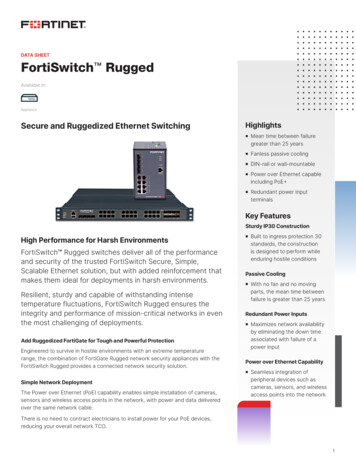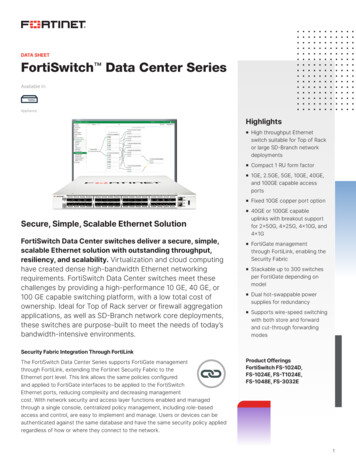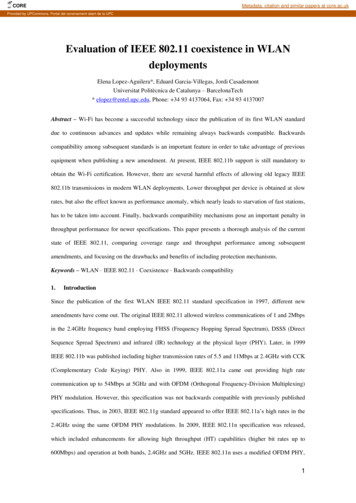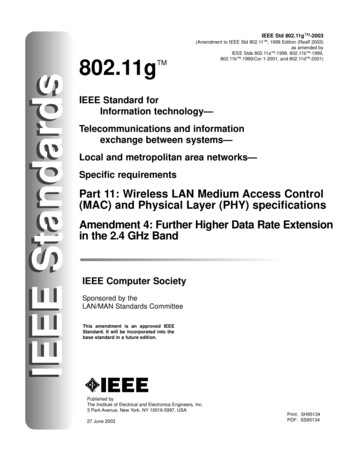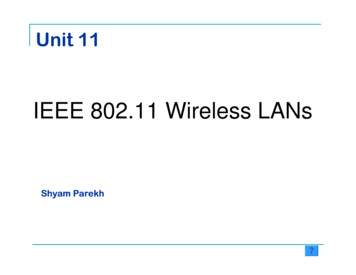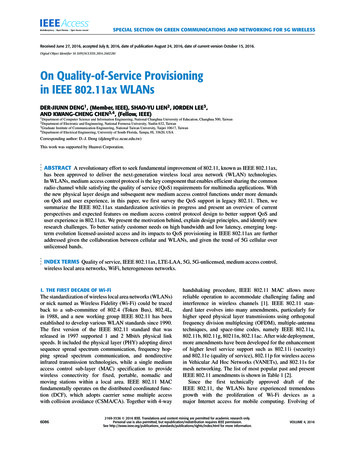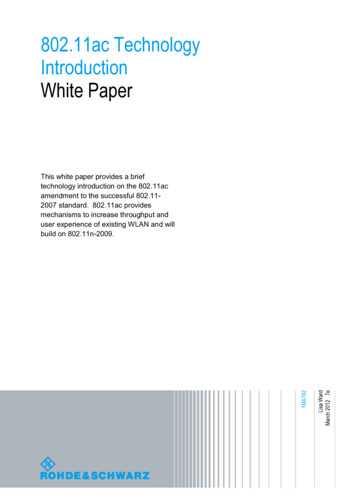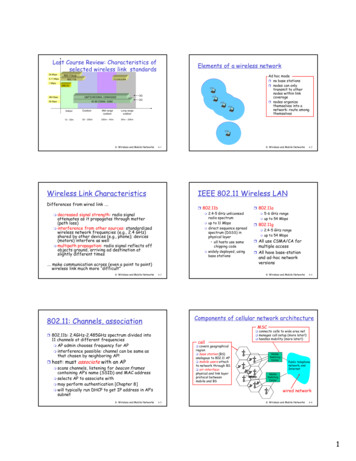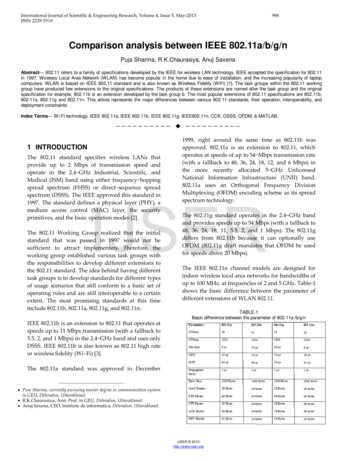
Transcription
International Journal of Scientific & Engineering Research, Volume 4, Issue 5, May-2013ISSN 2229-5518988Comparison analysis between IEEE 802.11a/b/g/nPuja Sharma, R.K.Chaurasiya, Anuj SaxenaAbstract— 802.11 refers to a family of specifications developed by the IEEE for wireless LAN technology. IEEE accepted the specification for 802.11in 1997. Wireless Local Area Network (WLAN) has become popular in the home due to ease of installation, and the increasing popularity of laptopcomputers. WLAN is based on IEEE 802.11 standard and is also known as Wireless Fidelity (WiFi) [1]. The task groups within the 802.11 workinggroup have produced few extensions to the original specifications. The products of these extensions are named after the task group and the originalspecification for example, 802.11b is an extension developed by the task group b. The most popular extensions of 802.11 specifications are 802.11b,802.11a, 802.11g and 802.11n. This article represents the major differences between various 802.11 standards, their operation, interoperability, anddeployment constraints.Index Terms— Wi-Fi technology, IEEE 802.11a, IEEE 802.11b, IEEE 802.11g, IEEE802.11n, CCK, DSSS, OFDM, & MATLAB.—————————— ——————————1 INTRODUCTIONThe 802.11 standard specifies wireless LANs thatprovide up to 2 Mbps of transmission speed andoperate in the 2.4 GHz Industrial, Scientific, andMedical (ISM) band using either frequency hoppingspread spectrum (FHSS) or direct sequence spreadspectrum (DSSS). The IEEE approved this standard in1997. The standard defines a physical layer (PHY), amedium access control (MAC) layer, the securityprimitives, and the basic operation modes [2].1999, right around the same time as 802.11b wasapproved. 802.11a is an extension to 802.11, whichoperates at speeds of up to 54 Mbps transmission rate(with a fallback to 48, 36, 24, 18, 12, and 6 Mbps) inthe more recently allocated 5 GHz UnlicensedNational Information Infrastructure (UNII) band.802.11a uses an Orthogonal Frequency DivisionMultiplexing (OFDM) encoding scheme as its spreadspectrum technology.IJSERThe 802.11 Working Group realized that the initialstandard that was passed in 1997 would not besufficient to attract implementers. Therefore, theworking group established various task groups withthe responsibilities to develop different extensions tothe 802.11 standard. The idea behind having differenttask groups is to develop standards for different typesof usage scenarios that still conform to a basic set ofoperating rules and are still interoperable to a certainextent. The most promising standards at this timeinclude 802.11b, 802.11a, 802.11g, and 802.11n.IEEE 802.11b is an extension to 802.11 that operates atspeeds up to 11 Mbps transmission (with a fallback to5.5, 2, and 1 Mbps) in the 2.4 GHz band and uses onlyDSSS. IEEE 802.11b is also known as 802.11 high rateor wireless fidelity (Wi Fi) [3].The 802.11g standard operates in the 2.4 GHz bandand provides speeds up to 54 Mbps (with a fallback to48, 36, 24, 18, 11, 5.5, 2, and 1 Mbps). The 802.11gdiffers from 802.11b because it can optionally useOFDM (802.11g draft mandates that OFDM be usedfor speeds above 20 Mbps).The IEEE 802.11n channel models are designed forindoor wireless local area networks for bandwidths ofup to 100 MHz, at frequencies of 2 and 5 GHz. Table-1shows the basic difference between the parameter ofdifferent extensions of WLAN 802.11.TABLE-1Basic difference between the parameter of 802.11a /b/g/nThe 802.11a standard was approved in —— Puja Sharma, currently pursuing master degree in communication systemin GEU, Dehradun, Uttarakhand. R.K.Chaurasiya, Asst. Prof. in GEU, Dehradun, Uttarakhand. Anuj Saxena, CEO, institute de informatica, Dehradun, Uttarakhand.IJSER 2013http://www.ijser.org
International Journal of Scientific & Engineering Research, Volume 4, Issue 5, May-2013ISSN 2229-55189892 Discussion about various extensions[4]. The data is transmitted by first modulating abinary string called spreading code. A random binarystring is used to modulate the transmitted signal. Thisrandom string is called the spreading code. Thetransmitter and the receiver must be synchronizedwith the same spreading code. Recovery is faster inDSSS systems because of the ability to spread thesignal over a wider band.2.1 802.11b Limitations802.11b is haunted by the possibility of interference inthe 2.4 GHz frequency band in which it operates.However, the 2.4 GHz frequency is already crowdedand will soon be more so. An even greater threat to802.11b stability is just around the corner. Blue tooth,the short range wireless networking standard, whichalso operates in the 2.4 GHz range, is slated to coexistwith wireless LANs. Bluetooth is not bothered a bit by802.11b signals, but not vice versa. Depending on theproximity and number of devices, Bluetooth can havea negative impact on the performance of an 802.11bconnection due to electromagnetic interference causedby the Bluetooth devices. Fig -1 shows the bit errorrate versus Es/N0 at different data rate for 802.11bextension. The bit error rates for different data rateare shown in table-2.TABLE -2BER rate for IEEE 802.11b2.1.1 802.11b interoperability and compatibilitywith 802.11IJSER2.1.3 Frequency Hopping Spread Spectrum(FHSS)802.11b devices are backward compatible with 802.11implementations, which use the DSSS as theirspectrum technology. Therefore, 802.11b devicesoperate at lower speeds when they are connected toan 802.11 network. 802.11b devices are not compatiblewith the HomeRF devices because HomeRF uses theFHSS standard.The carrier frequency at which the informationbearing signal is transmitted is rapidly changedaccording to the spreading code. The transmitter thenhops between the sub channels sending out shortbursts of data for a given time. In order for FHSS towork correctly, both communicating ends must besynchronized otherwise they lose the data. FHSS ismore resistant to interference because of its hoppingnature.2.2 IEEE 802.11a802.11a is an extension to 802.11, which operates atspeeds of up to 54 Mbps transmission rate (with afallback to 48, 36, 24, 18, 12, and 6 Mbps) in the morerecently allocated 5 GHz Unlicensed NationalInformation Infrastructure (UNII) band. 802.11a usesan Orthogonal Frequency Division Multiplexing(OFDM) encoding scheme as its spread spectrumtechnology.Fig. 1 BER rate for IEEE 802.11b on different data rate using AWGNchannel2.1.2 Direct Sequence(DSSS)SpreadSpectrumIn DSSS the information-bearing signal is multiplieddirectly by a high chip rate spreading code. Thetransmission signal is spread over an allowed band2.2.1OrthogonalMultiplexing (OFDM)FrequencyDivisionOFDM technique distributes the data to betransmitted into smaller pieces, which aresimultaneously transmitted over multiple frequencychannels that are spaced apart. This spacing providesIJSER 2013http://www.ijser.org
International Journal of Scientific & Engineering Research, Volume 4, Issue 5, May-2013ISSN 2229-5518the orthogonality that prevents the demodulatorsfrom seeing frequencies other than their own. Whentransmitting data using OFDM [5], the data is firstdivided into frames and a mathematical algorithmknown as Fast Fourier Transformation (FFT) isapplied to the frame, then OFDM parameters (forexample, timing) are added. An Inverse Fast FourierTransformation (IFFT) is then applied on each frame.The resulting frames are then transmitted over thedesignated frequencies. A receiver performs theinverse operations to get the transmitted data byperforming FFT on the frames. The benefits of OFDMare high spectral efficiency, resiliency to RFinterference, and lower multipath distortion.990IEEE 802.11g and table-4 shows values of SNR fordifferent values of BER.TABLE -3BER rate for different modulation using Rayleigh channel for802.11aIJSERFig. 2 BER rate for different modulation using Rayleigh channel for802.11aFig -2 shows the bit error rate versus Eb/N0 comparisonbetween different modulation techniques using Rayleighchannel for 802.11a extension. The bit error rate fordifferent modulation techniques are shown in table-3.2.3 802.11gIEEE 802.11 adopted the 802.11g standard in late 2001.The 802.11g [6] standard is still under development.The 802.11g standard operates in the 2.4 GHz bandand provides speeds up to 54 Mbps (with a fallback to48, 36, 24, 18, 11, 5.5, 2, and 1 Mbps). The 802.11gdiffers from 802.11b because it can optionally useOFDM [7]. The most important enhancement offeredby 802.11g is its higher speed. The ability to operateup to 54 Mbps provides 802.11g a higher edge overother 802.11 compliant devices that operate in the2.4 GHz band. The support of OFDM is anotherenhancement that 802.11g maintains over the basic802.11 standard.Fig.3 shows the BER/SNR plot forFig. 3 BER rate for 802.11g using OQPSK modulation2.3.1 802.11g ApplicationsThe 802.11g devices are not available yet. However,electrical industry analysts predict that when 802.11gbecomes available, it would be the only choice thatusers would consider, as it provides the directupgrade path and interoperability with the 802.11bstandard devices.2.3.2 802.11g LimitationsIJSER 2013http://www.ijser.org
International Journal of Scientific & Engineering Research, Volume 4, Issue 5, May-2013ISSN 2229-5518991Though 802.11g devices would provide higherspeed than the currently available 802.11bdevices, it still suffers the interference issue withother devices operating in the same RF band;primarily the Bluetooth devices.TABLE -4SNR/BER using OQPSK modulation for IEEE 802.11gSNR0246810121416182.4 IEEE Fig.4 Welch power spectral density estimate for antenna 1 in802.11nIJSERThe IEEE 802.11n amendment is the latest additionunder development for the IEEE 802.11 standardproviding a marked increase in throughput (from 20Mbps to around 200 Mbps, in practice) as well asrange of reception (through reducing signal fading)over the IEEE 802.11a/g standards currently in use.Multiple antennas, or MIMO (Multiple-Input,Multiple-Output), is the key innovation used to obtainthese benefits. The current draft for the IEEE 802.11namendment supports the use of MIMO features suchas spatial-division multiplexing (SDM) [8], space-timeblock coding (STBC) and transmitter beam forming. Inaddition, there are provisions for the use of advancedcoding with LDPC (low-density parity check codes),as well as a 40 MHz bandwidth mode (known aschannel bonding). The above features allow the IEEE802.11n amendment to specify data rates up to 600Fig.5 Welch power spectral density estimate for antenna 2 in802.11nTABLE- 5Comparison between different versions ofMbps, a more than ten-fold increase over themaximum data rate with the 11a/g standards.IJSER 2013http://www.ijser.org802.11
International Journal of Scientific & Engineering Research, Volume 4, Issue 5, May-2013ISSN 2229-5518Fig.6 Fading envelopes for Tx1-Rx1 and Tx2-Rx1 for 802.11n992Fig.9 Fading envelopes for Tx2-Rx1 and Tx2-Rx2 for 802.11nIJSERFig.7 Fading envelopes for Tx1-Rx2 and Tx2-Rx2 for 802.11nFig. 10 BER rate for 802.11n using MIMO2.4.1 MIMO ChannelMIMO exploits the use of multiple signals transmittedinto the wireless medium and multiple signalsreceived from the wireless medium to improvewireless performance [9]. MIMO can provide manybenefits, all derived from the ability to processspatially different signals simultaneously. Twoimportant benefits explored here are antennadiversity and spatial multiplexing. Using multipleantennas, MIMO technology offers the ability tocoherently resolve information from multiple signalpaths using spatially separated receive antennas.Fig.8 Fading envelopes for Tx1-Rx1 and Tx1-Rx2 for 802.11nMultipath signals are the reflected signals arriving atthe receiver some time after the original or line ofsight (LOS) signal has been received. Multipath istypically perceived as interference degrading aIJSER 2013http://www.ijser.org
International Journal of Scientific & Engineering Research, Volume 4, Issue 5, May-2013ISSN 2229-5518receiver’s ability to recover the intelligentinformation. MIMO enables the opportunity tospatially resolve multipath signals, providingdiversity gain that contributes to a receiver’s ability torecover the intelligent information. Fig.4 to Fig.9shows spectral power density curve and fadingenvelops for different pair of antennas for IEEE802.11n and Fig.10 shows improved bit error rate byusing mimo system in IEEE 802.11n.[9]Boris Ginzburg, Alex Kesselman, "Performance Analysis of AMPDU and A-MSDU Aggregation in IEEE 802.11n," March 03,2010 IEEE Xplore.Table -5 shows the comparison between differentextensions of IEEE 802.11 by using differentparameters like operating frequencies, modulationtechniques, data rates, range etc.3 CONCLUSIONIn this paper we have analyzed the different extensions ofIEEE 802.11 (802.11a, 802.11b, 802.11g, 802.11n), theirperformance results and compared all these technologies onthe basis of their data rates, range, modulation techniquesused and operating frequency band. Also we havediscussed the bit error rate versus bit/symbol energy tonoise ratio plots & described the BER for differentmodulation techniques that has been used in differentextensions of 802.11.4 REFERENCES[1][2][3][4][5][6][7][8]993IJSERJahanzeb khan, Anis Khwaja “Building Secure Wireless Networkswith 802.11,” Wiley Publishing, Inc. Copyright 2003.LAN/MAN Standards Committee of the IEEE Computer Society,“Wireless LAN Medium Access Control (MAC) and Physical Layer(PHY) specifications High-speed Physical Layer in the 5 GHzBand,” Adopted by ISO/IEC and redesignated as ISO/IEC 880211:1999/Amd 1:2000(E).Guido R. Hiertz, Dee Denteneer, Philips Lothar Stibor and YunpengZang, Xavier Pérez Costa, “The IEEE 802.11 Universe,” IEEECommunications Magazine January 2010.Dimitris Vassis, George Kormentzas, Angelos Rouskas, and IliasMaglogiannis University of the Aegean, “The IEEE 802.11gStandard for High Data Rate WLANs,” IEEE Network May/June2005.Narendra Giradkar, G.M.Asutkar, Abhijit Maidamwar, “OFDM basedPHY Performance of IEEE 802.11a Using various practical channelmodels,” International Journal of Soft Computing and Engineering(IJSCE) ISSN: 2231-2307, Volume-1, Issue-4, September 2011.Minal S. Hardas, Amutha JeyaKumar , Electrical Department,Mumbai University Veermata Jijabai Technological Institute,Matunga, “Comparative Analysis of IEEE 802.11b At 2 Mbps & 11Mbps,” IJCSET April 2012 Vol 2, Issue 4,1098-1101.JAN MIKULKA, STANISLAV HANUS, Brno University ofTechnology, "IEEE 802.11g Baseband Physical Layer Simulation,"5th WSEAS Int. Conference on Applied Electromagnetics, Wirelessand Optical Communications, Tenerife, Spain, December 14-16,2007.LAN/MAN Standards Committee of the IEEE Computer Society,“Part: 11 Wireless LAN Medium Access Control (MAC) andPhysical Layer (PHY) specifications High-speed Physical Layer inthe 5 GHz Band,” Amendment to IEEE Std 802.11 , 1999 Edition(Reaff 2003) IEEE Std 802.11g-2003 .IJSER 2013http://www.ijser.org
The IEEE 802.11n amendment is the latest addition under development for the IEEE 802.11 standard providing a marked increase in throughput (from 20 Mbps to around 200 Mbps, in practice) as well as range of reception (through reducing signal fading) over the IEEE 802.11a/g standards curr

